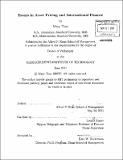Essays in asset pricing and international finance
Author(s)
Tian, Mary
DownloadFull printable version (7.155Mb)
Other Contributors
Sloan School of Management.
Advisor
Leonid Kogan.
Terms of use
Metadata
Show full item recordAbstract
This thesis consists of three chapters in asset pricing and international finance. In Chapter 1, I examine the effect of tradability, the proportion of a firm's output that is exported, on its stock returns. The empirical patterns are consistent with the adjustment of the relative price of tradable to non-tradable goods, due to endowment shocks. I find firms that produce tradable goods have asset returns and earnings that are twice as cyclical as firms that produce non-tradable goods. A tradable minus nontradable portfolio of stock returns can predict changes in real exchange rates and the relative quantity of exports. A two-country endowment economy model formalizing the relative price mechanism is able to match the empirical facts. In Chapter 2, joint with Leonid Kogan and Roberto Rigobon, we take an openeconomy perspective on consumption growth predictability. We find that the combination of the U.S. and the world real interest rates predicts U.S. consumption growth. Predictability is highly significant, both statistically and economically, and is strongest at horizons of two to three years. The growth rate of consumption of services is more predictable than the growth rate of consumption of nondurable goods. We interpret this evidence using a two-country equilibrium exchange economy model and conclude that the predictive relation between interest rates and consumption growth is likely generated by output shocks in the non-tradable good sector. In Chapter 3, joint with Leonid Kogan, we examine the effects of data snooping on the performance of linear factor models at explaining asset pricing anomalies. We gather 22 anomalies established in the literature and create three-factor models from sorting firms into portfolios with respect to these anomalies. From 1950-2007, half of the factor models we construct can explain 31% or more of anomalies. In comparison, the CAPM and Fama French models rank in the 20th and 40th percentile of models respectively. Factors constructed from sorting by external financing characteristics (net stock issues and composite issuance) are able to explain a large proportion of anomalies. None of the models are able to explain momentum.
Description
Thesis (Ph. D.)--Massachusetts Institute of Technology, Sloan School of Management, 2011. Cataloged from PDF version of thesis. Includes bibliographical references (p. 109-115).
Date issued
2011Department
Sloan School of ManagementPublisher
Massachusetts Institute of Technology
Keywords
Sloan School of Management.